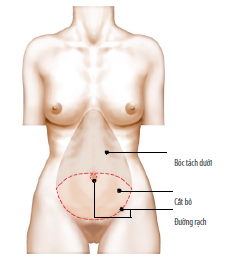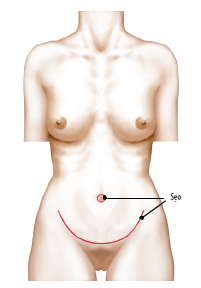Table of contents
This document has been conceived under the authority of the French Society of Plastic Reconstructive and Aesthetic surgery (Société Française de Chirurgie Plastique Reconstructrice et Esthétique – SOFCPRE) to complete the information that you received in your first consultation with your Plastic Surgeon. It aims to answer all the questions that you might ask, if you decide to undertake abdominoplasty (also called «Tummy Tuck»). The aim of this document is to give you all the essential information you need in order to make an informed decision, with full knowledge of the facts related to this procedure. Consequently, we strongly advise you to read it carefully.
DEFINITION AND FOREWORD
Abdominal skin and fat excess often alter self confidence. Liposuction has improved dramatically the outcome of abdominal aesthetic surgery, by reducing the amount and the length of scars.
There are different types of abdominoplasty depending on the patient’s examination. The following parameters will inluence the surgeon’s final decision: skin quality, amount of fat tissue, abdominal muscle tonicity and the overall patient’s morphology: the most adapted strategy will be applied to each case.
Usually, there are two kinds of abdominal wall plastic surgery: one requiring isolated abdominal liposuction or one requiring abdominoplasty
Isolated abdominal liposuction
Please read the document about LIPOSUCTION
ABDOMINOPLASTY or ABDOMINAL DERMOLIPECTOMY
Whenever there is significant damage to the skin, with a significant distension, many stretch marks and even scars, liposuction alone will be insufficient and this will require an abdominoplasty.
GOALS AND PRINCIPLES
The aim of this procedure is to remove the impaired abdominal skin (stretched skin, scars, stretch-marks) and tighten the remaining surrounding skin.
Localized fat excess can be removed during the same procedure by liposuction and impaired abdominal wall muscles may be treated too (widening, herniae).
The extended abdominoplasty:
The standard abdominoplasty (tummy tuck) removes a large amount of redundant tissue (skin and fat) from the middle and lower abdominal wall, between the belly button (umbilicus) and the pubic region, according to preoperative planning.

The healthy skin, as a general rule located above the navel, is redraped down in order to reconstruct an abdominal wall with good quality skin.
The belly button is preserved and put in its normal position through a hole cut and contoured in the newly draped skin.
The operation always leaves a scar more or less long and can be more or less seen accordingly with the importance and the localized skin where the ablation is performed.
Most often, this scar is located at the upper edge of pubic hair and runs more or less into the folds of the groin. Its length is expected before surgery: the patient should be warned very clearly.
Extended abdominoplasty can be handled by the health insurance in some cases and under some conditions:
The localized abdominoplasty:

In the presence of smaller abnormalities, sometimes a localized abdominoplasty with smaller scars can be proposed.
Reimbursement by health insurance may not be considered in these cases.
BEFORE THE OPERATION
A preoperative check-up is made according to your surgeon’s recommendations.
The anaesthesiologist will be seen in consultation at latest, 48 hours prior to surgery.
Tobacco cessation is strongly recommended at least one month before and one month after the intervention (smoking can cause a delayed healing).
Stopping oral contraceptives may be required, particularly if risk factors (obesity, poor venous bleeding disorder) are present.
No medication containing aspirin will be taken for 10 days before surgery.
Type of anesthesia and hospital stay duration
Type of anesthesia :Abdominoplasty is usually performed under general anaesthesia. The patient is asleep through the entire operation.
Hospital stay : The duration of hospital stay is usually 2 to 5 days.
The procedure
Every surgeon has his or her personal technical habits which he or she adapts to every new case, in order to obtain the best possible results. However, there are common principles:
The position of the skin incisions, which will correspond to the future scars, depends on the amount of skin to be removed. The more skin there is to remove, the longer are the remaining scars.
The excessive fat is aspirated with liposuction and the stretched abdominal wall muscles are tightened.
A molding dressing is made at the end of the procedure.
Depending on your surgeon and the extent of fat and skin tissue necessary to remove, the operation takes about 90 minutes to 3 hours.
AFTER THE OPERATION: POST-OPERATIVE EFFECTS
It is recommended to wear a pressure garment for 2 to 4 weeks, day and night.
You shall not go to work for 2 to 4 weeks.
The scars are often red during the first 2 or 3 months and progressively become paler starting from the third month onwards, during a period of 1 to 3 years. The scars should be protected from sunlight and UV for at least 3 months.
Sporting activities can be progressively started after 6 weeks.
THE RESULT
It can be best appreciated one year after the procedure: During this period, it is recommended to be patient while scars slowly fade, and collaborate with your physician for a regular follow-up consultation every 3 months during one year.
Concerning scars, you should know that they do fade away with time but never completely disappear. The surgeon does the sawing, but scarring is a patient-related process.
However, abdominoplasty offers an often noticeable aesthetic improvement. It enhances the patient’s comfort, quality of life and self confidence, thus helping him or her to reach for a better weight-control.
Moreover, this functional improvement and better psychological help the patient or the patients in adjusting their balance weight.
The goal of this surgery is to make an improvement and not to achieve perfection. If your wishes are realistic, the result should give you great satisfaction.
Anyway, this is an important and delicate surgery, for which quality indication and the severity of the surgical procedure are not in any way to protect a number of imperfections or complications.
Imperfect results
Most of the time, a properly indicated abdominoplasty can offer a real improvement to patients in terms of satisfying results and conformity to their expectations.
In some cases, localized imperfections can be observed, which must be distinguished from genuine complications:
- The scar can be a bit too visible, adherent or asymmetric. It can sometimes become widened, hypertrophic or bumpy (cheloid).
- The belly button may look unnatural.
- In some case, when there is excessive tension on the scar.
- The pubic hair can be raised upwards.
These imperfections result are generally accessible to further treatment, “touch” surgery, performed under local anaesthesia or local anaesthesia plus sedation from the 12th month after surgery in ambulatory regimen.
Possible complications
Abdominoplasty, even if performed for aesthetic reasons, is a genuine surgical procedure, with the consequent risks related to all medical acts, no matter how mild they might appear.
There are surgical and aesthetic complications:
- Concerning anaesthesia, the anaesthesiologist will inform you about all the anaesthetic You must be aware that anaesthesia can sometimes cause unpredictable body reactions that can be difficult to control. The presence of an experienced anaesthesiologist, in a surgical environment, means that the risks are statistically practically negligible.
In fact, techniques, products and monitoring methods have progressed considerably over the last twenty years, offering optimal safety, especially when the operation is elective and the patient is in good general health.
- Concerning surgery: by choosing a competent and qualified Plastic Surgeon, experienced in performing this procedure, you limit, but do not entirely eliminate, surgical risks.
Indeed, some complications can occur after abdominoplasty which constitutes one of the heaviest procedures in Plastic and Aesthetic Surgery.
Among possible complications, you must be aware of the followings:
- Thrombo-embolic accidents (blood clot in the veins of the legs, pulmonary embolism) are rare, but can be life threatening. They can be prevented by strict prophylactic measures, such as standing and walking as soon as possible after surgery, wearing compression stockings, or heparin therapy (low doses of heparin injected under the skin).
- Blood clots (haematomas) are quiet rare but can occur. They can be evacuated to prevent an impairment of the final aesthetic result.
- Infection, though uncommon, can be treated with drainage and antibiotics
- It is common to notice 8 days after surgery a lymph collection accumulating under the skin. Such a collection can be drained and will dry up rapidly without sequela.
- Localised skin necrosis. Large areas of necrosis is rare. They can be prevented by a proper preoperative examination and a cautious and well-executed operation, with moderate tension on sutures.
- Numbness of abdominal skin may be observed, frequently in the lower parts of the abdominal wall. It is usually transient and most patients recover normal feeling after 3 to 12 months.
- In some patients with very damaged skin or skin with poor circulation, the healing process may be delayed.

GENERAL CONCLUSION ABOUT PLASTIC AND AESTHETIC SURGERY OF THE ABDOMINAL WALL
Plastic and aesthetic surgery of the abdominal wall has made dramatic progress. There are techniques and strategies (isolated liposuction, mini or plain abdominoplasties) which can solve most of the aesthetic problems encountered in the abdominal area.
All things considered, the risks must not be overestimated, but you must be conscious that an operation, even a minor one, always has some degree of unforeseenable unknown factors.
You can be assured that if you are operated on by a qualified Plastic Surgeon, he will have the experience and skill required to avoid these complications, or to treat them successfully if necessary.
Tell us what you think.
These booklets are regularly reviewed.
We welcome any suggestions to help us improve this booklet. You should send these to Patient and Family Eduacation Commitee, Fv Hospital, 06 Nguyen Luong Bang Street, Saigon South (Phu My Hung), District 7, Ho Chi Minh City, Vietnam

